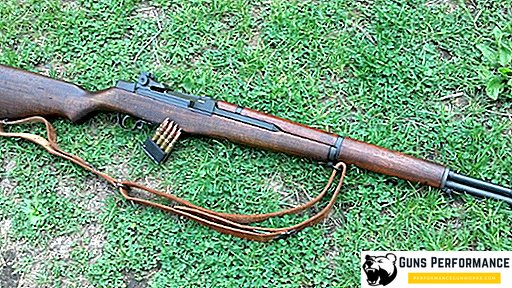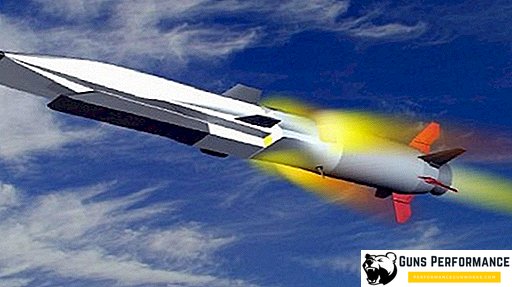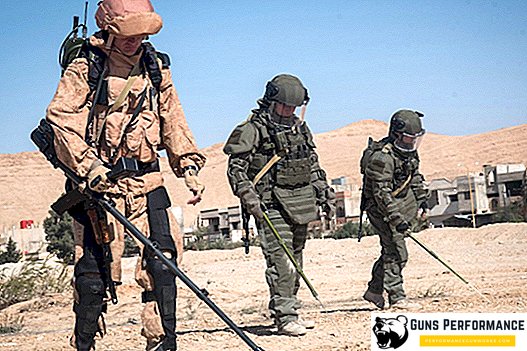The M1 Garand is a legendary American self-loading rifle from World War II, created by talented Canadian weapons designer John Garand. She became the first semi-automatic rifle, which was officially adopted as the main weapon of an infantryman. The first semi-automatic rifle, adopted by the armed forces, was the Soviet ABC-36, but it was never the main weapon of the Soviet infantry. Officially, the M1 Garand rifle was called the US Rifle, Caliber.30, M1.

The M1 Garand rifle has gone a glorious military way, for Americans, this weapon means no less than for us the PCA machine gun or the Mosin rifle. For the first time these weapons were used in North Africa, then there was Sicily, the landing on the Normandy coast, the crossing of the Rhine and the Pacific theater of operations. Americans actively used the M1 during the Korean War.
The M1 Garand rifle was only withdrawn from the US Army in 1957, but it is still very popular among those who love small arms.
History of the M1 Garand
The first attempts to create automatic weapons were made in the late XIX - early XX century. True, nothing sensible happened: the first samples were heavy, expensive to manufacture and were not distinguished by reliability.

The issue of creating new types of automatic weapons rose sharply during the First World War. The experience of this conflict has shown the crucial importance of a high density of fire. Machine guns perfectly suited for defense, they created a real lead squall in front of the advancing infantry. But for offensive action machine guns were not good. It was necessary easy and reliable rapid-fire weapons, suitable for attack.
Weapon designers worked in two directions at once: in the development of submachine guns, which used pistol ammunition and in the development of self-loading rifles based on existing rifle ammunition.
It should be said that each of these types of automatic weapons had both its own advantages and serious shortcomings. The success of a particular sample of a submachine gun or a self-loading rifle depended more on the luck and talent of the designer who created it.

One of these designers was John Garand, who began work on the creation of a self-loading rifle during World War I. At first, Garand developed a weapon for a 7 mm caliber cartridge, but later the US military leadership refused to use this ammunition as the main one.
In general, the first prototype of a future self-loading rifle, called the TK, was ready by 1929. Automation in it worked by the removal of powder gases from the barrel, its locking was done by turning the shutter, and the gas piston had a return spring.
However, the process of testing and refinement of weapons was delayed. Only in 1936 the rifle received an M1 index and was adopted by the US Army. Almost immediately after the arrival of the M1 Garand in the army, dozens of complaints fell on the rifle. Their main reason was the constant delays during the shooting. On this occasion, a special commission was even created, which decided to urgently modify the weapon.

In the first place, the gas exhaust system needed modernization. Already in 1939, Garand presented an improved version of the rifle, which was sent to the army for tests and successfully passed them. In 1941, the serial production of the new upgraded version of the M1 began, and the samples that had been released earlier had to be redone.
Currently, modifications of the M1 Garand, released before 1941, in the world almost gone. They are very valuable for collectors of weapons and cost more than 20 thousand dollars.
Despite the fact that at this time the US Army was already actively involved in the fighting, the rifle supplies to the troops were rather sluggish, and at the first stage of World War II most of the American infantrymen used outdated Springfield M1903.

In 1941, a new 7.62x33mm cartridge appeared and it was decided to create a carbine based on the M1 Garand rifle. The development of new weapons also dealt directly with John Garand. Carabiner immediately fell in love with the fighters. The soldiers gave him the affectionate nickname "baby garand."
The new carbine was especially good in melee, at short distances it surpassed even submachine guns in accuracy. True, the aimed fire from the baby garand could only be conducted at distances of no more than 300 meters, but this was due to the shape of the bullet, and not to the design of the carbine.
The baby-garand carabiner had a replaceable magazine for 15 rounds, its weight was 2.6-2.8 kg. In 1944, a modification of the carbine appeared, which could fire in bursts. This modification has acquired a new store with a capacity of 30 rounds.

After creating the automatic rifle, Garand set about creating a fully automatic modification of the M1 rifle. It also appeared in 1944, received the T20 index, 85% of its parts were unified with the M1 Garand. A new modification of the rifle received a replacement magazine for 20 rounds.
In addition to the standard M1 Garand rifle, there were also two of its sniper modifications:
- rifle M1C, which was released in 1944 and equipped with an M81 rifle scope;
- M1D rifle, on which the M82 sight was mounted.
There were also other modifications based on the M1 Garand in other countries.
M1 Garand rifle participated in the Korean War, it was also used during the fighting in Vietnam. In the Vietnam conflict, this rifle was armed with Viet Cong and Chinese volunteers.
A total of 5.5 million units of various modifications of the M1 rifle and 6.3 million units of the M1 carbine were released.

Description of the M1 Garand rifle
The M1 Garand is a self-loading rifle, the automation of which operates at the expense of the energy of the powder gases discharged from the barrel. Its locking occurs due to the rotation of the shutter.
The gas piston and the bolt carrier unit is a single whole, while turning the bolt rests on two projections into the grooves of the receiver.
The trigger mechanism (trigger) of the hammer type, it is made as a separate module, when disassembling the weapon is removed completely and has a very simple and reliable design. It was so successful that later the construction of the trigger for the M1 Garand rifle was repeatedly copied when creating other types of weapons.

The rifle also had a very convenient fuse in the form of a lever flap, which was placed inside the trigger guard. The fighter could always determine by touch whether his rifle is protected or not.
The rifle was powered by a pack in which eight cartridges were placed. It was inserted into the store through an open bolt and was thrown through it after the ammunition was completely consumed.
Due to the bolt lag, the frame remained in the rear position after the last ammunition was used, which significantly accelerated and facilitated the process of reloading the weapon. The fighter just needed to get and insert the next pack of cartridges into the store.

This method of charging a rifle significantly increased its practical rate of fire, but had some drawbacks. The release of an empty pack was accompanied by a characteristic sound that could tell the enemy that the soldier ran out of ammunition. Often, the Japanese used it and managed to run up and destroy the fighter.
However, experienced fighters have learned to use even this shortcoming: they imitated the sound of ejection of an empty pack from the store and calmly dealt with the enemy.
Charging a rifle with a pack had another weak point: the weapon could not be recharged. In addition, there were quite high requirements for the quality of workmanship of the pack itself.
The question of whether the ringing of the discarded tutu was a serious shortcoming of the M1 Garand is still controversial. This topic was once discussed at a meeting of American and German veterans, the latter called this flaw ridiculous, saying that it was impossible to hear such a noise during a fight.

Aim devices consisted of a fly, closed on both sides and a diopter pillar.
A sniper mount was mounted on an optical sight, which was shifted away from the axis of the weapon, so as not to hinder the extraction of sleeves and empty packs.
The M1 Garand rifle's box was made of wood, the forend and upper pad separately.
M1 was completed with a bayonet, as well as a muzzle, which was used to shoot rifle grenades.

Advantages and disadvantages of the M1 Garand
The M1 Garand self-loading rifle is an excellent example of small arms, the main advantages of which were simplicity, reliability, excellent firing rate and good accuracy of shooting. Given the fact that the M1 Garand was one of the first self-loading rifles, it can be considered an outstanding example of small arms, and its creator is a talented weapon designer.
The advantages of the M1 over a conventional rifle were obvious. In one minute, the average shooter could produce almost twice as many shots as from a conventional magazine rifle.

There were M1 shortcomings, almost all of them are related to the ammunition that this rifle used. The cartridge had excessive power, which made the construction much heavier, making it unnecessarily complicated and expensive.
All these problems were solved only after the appearance of automatic weapons created for intermediate ammunition. But that's another story.

Technical characteristics ТТхХ M1 Garand
| Producing country | USA |
| Type of cartridge | 30-06 springfield |
| Length mm | 1100 |
| Barrel length, mm | 609,6 |
| Weight, kg | 5,3 |
| Rifling | 4 right |
| Bundle Capacity | 5, 6 or 8 |
| Sighting range, m | 550 |
| Maximum range, m | 2743 |












